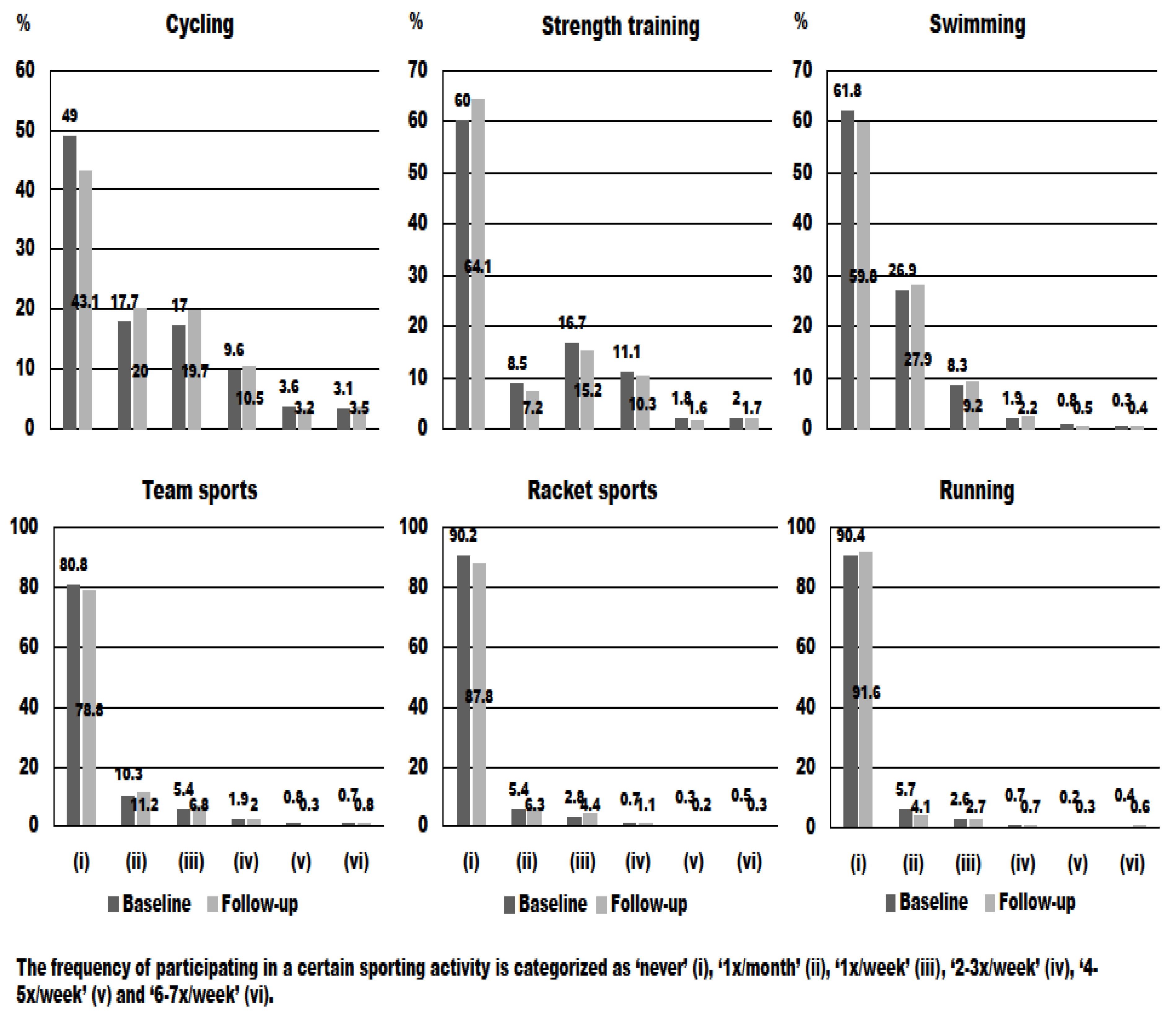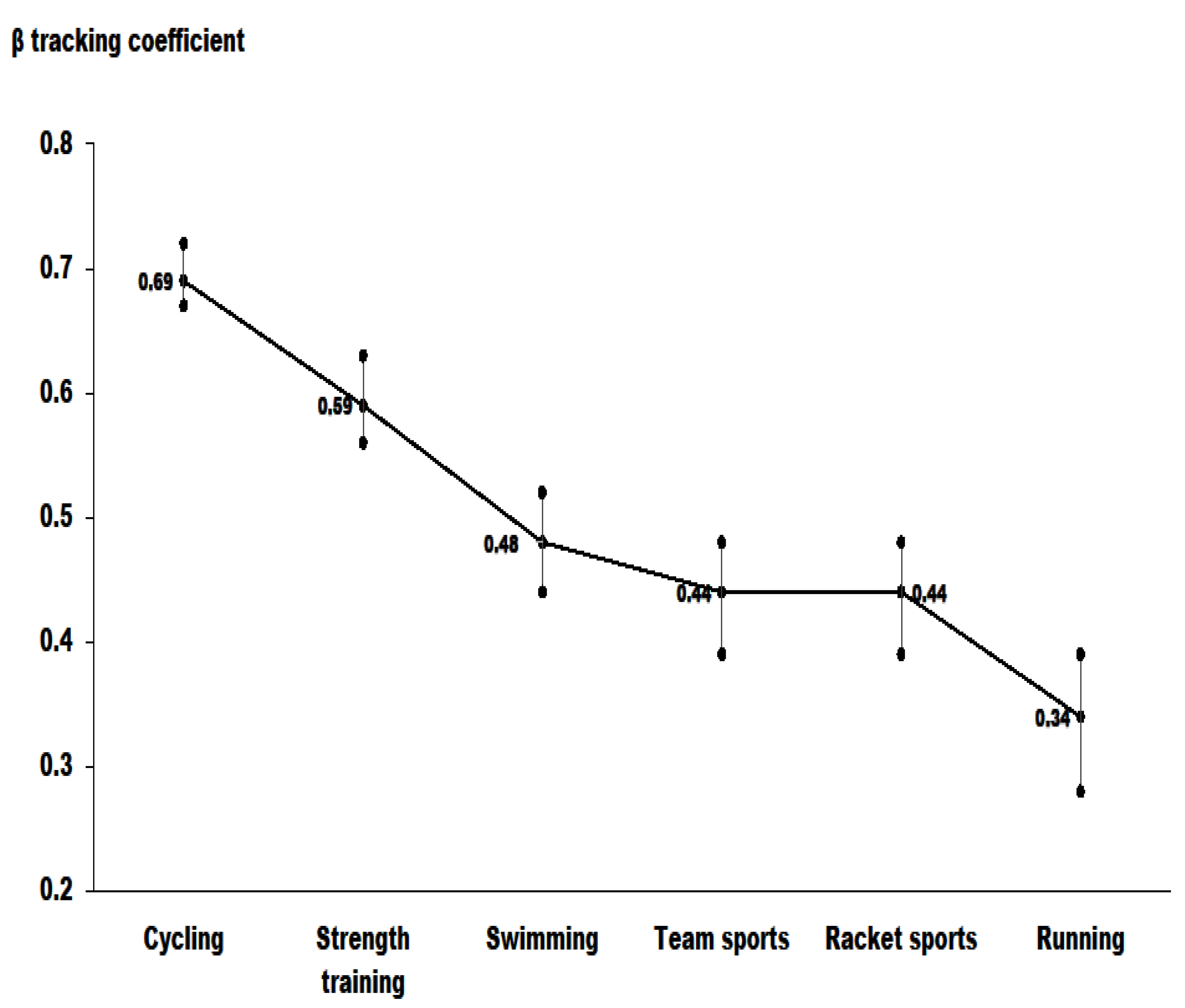Tracking of Maternal Physical Activity and Sport Participation over 11 Years: Findings from the Czech ELSPAC Study
Abstract
:1. Background
2. Materials and Methods
2.1. Study Design and Participants
2.2. Variables Used in the Study
2.3. Statistical Analysis
3. Results
4. Discussion
Strengths and Limitations
5. Conclusions
6. Perspective
Author Contributions
Funding
Institutional Review Board Statement
Informed Consent Statement
Data Availability Statement
Acknowledgments
Conflicts of Interest
References
- Guthold, R.; Stevens, G.A.; Riley, L.M.; Bull, F.C. Worldwide trends in insufficient physical activity from 2001 to 2016: A pooled analysis of 358 population-based surveys with 1.9 million participants. Lancet Glob. Health 2018, 6, 1077–1086. [Google Scholar] [CrossRef] [Green Version]
- Hankinson, A.L.; Daviglus, M.L.; Bouchard, C.; Carnethon, M.; Lewis, C.E.; Schreiner, P.J.; Liu, K.; Sidney, S. Maintaining a high physical activity level over 20 years and weight gain. J. Am. Med. Assoc. 2010, 304, 2603–2610. [Google Scholar] [CrossRef] [Green Version]
- Katzmarzyk, P.T.; Friedenreich, C.; Shiroma, E.J.; Lee, I.M. Physical inactivity and non-communicable disease burden in low-income, middle-income and high-income countries. Br. J. Sports Med. 2021, 56, 101–106. [Google Scholar] [CrossRef]
- Cramp, G.; Bray, S. Postnatal women’s feeling state responses to exercise with and without baby. Matern. Child Health J. 2010, 14, 343–349. [Google Scholar] [CrossRef]
- Centers for Disease Control and Prevention (CDC). Trends in leisure-time physical inactivity by age, sex, and race/ethnicity--United States, 1994–2004. MMWR Morb. Mortal. Wkly. Rep. 2005, 54, 991–994. [Google Scholar]
- Australian Bureau of Statistics 2012 Australian Health Survey: First Results, 2011–2012. ABS cat. no. 4364.0.55.001. Canberra: ABS. Available online: http://www.abs.gov.au/AUSSTATS/abs@.nsf/Lookup/4364.0.55.001main+features12011-12 (accessed on 27 November 2021).
- Albright, C.; Maddock, J.; Nigg, C. Physical activity before pregnancy and following childbirth in a multiethnic sample of healthy women in Hawaii. J. Women’s Health 2006, 42, 95–110. [Google Scholar] [CrossRef] [PubMed]
- Van Raaij, J.; Schonk, C.; Vermaat-Miedema, S.; Peek, M.; Hautvast, J. Energy cost of physical activity throughout pregnancy and the first year postpartum in Dutch women with sedentary lifestyles. Am. J. Clin. Nutr. 1990, 52, 234–239. [Google Scholar] [CrossRef] [PubMed] [Green Version]
- Telama, R. Tracking of physical activity from childhood to adulthood: A review. Obes. Facts. 2009, 2, 187–195. [Google Scholar] [CrossRef] [PubMed]
- Malina, R.M. Tracking of physical activity and physical fitness across the lifespan. Res. Q Exerc. Sport. 1996, 67, 48–57. [Google Scholar] [CrossRef]
- Foulkes, M.A.; Davis, C.E. An index of tracking for longitudinal data. Biometrics 1981, 37, 439–446. [Google Scholar] [CrossRef]
- Tudor-Locke, C.; Giles-Corti, B.; Knuiman, M.; McCormack, G. Tracking of pedometer-determined physical activity in adults who relocate: Results from RESIDE. Int. J. Behav. Nutr. Phys. Act. 2008, 5, 39. [Google Scholar] [CrossRef] [Green Version]
- Anderssen, N.; Jacobs, D.R., Jr.; Sidney, S.; Bild, D.E.; Stemfeld, B.; Slattery, M.L.; Hannan, P. Change and secular trends in physical activity patterns in young adults: A seven-year longitudinal follow-up in the Coronary Artery Risk Development in Young Adults Study (CARDIA). Am. J. Epidemiol. 1996, 143, 351–362. [Google Scholar] [CrossRef] [Green Version]
- De Bourdeaudhuij, I.; Sallis, J.; Vandelanotte, C. Tracking and explanation of physical activity in young adults over a 7-year period. Res. Q Exerc. Sport 2002, 73, 376–385. [Google Scholar] [CrossRef]
- Fortier, M.D.; Katzmarzyk, P.T.; Malina, R.M.; Bouchard, C. Seven-year stability of physical activity and musculoskeletal fitness in the Canadian population. Med. Sci. Sports Exerc. 2001, 33, 1905–1911. [Google Scholar] [CrossRef]
- Telama, R.; Yang, X.; Viikari, J.; Välimäki, I.; Wanne, O.; Raitakari, O. Physical activity from childhood to adulthood: A 21-year tracking study. Am. J. Prev. Med. 2005, 28, 267–273. [Google Scholar] [CrossRef]
- Kirjonen, J.; Telama, R.; Luukkonen, R.; Kääriä, S.; Kaila-Kangas, L.; Leino-Arjas, P. Stability and prediction of physical activity in 5-, 10-, and 28-year follow-up studies among industrial employees. Scand. J. Med. Sci. Sports 2006, 16, 201–208. [Google Scholar] [CrossRef] [PubMed]
- Friedman, H.S.; Martin, L.R.; Tucker, J.S.; Criqui, M.H.; Kern, M.L.; Reynolds, C.A. Stability of physical activity across the lifespan. J. Health Psychol. 2008, 13, 1092–1104. [Google Scholar] [CrossRef] [PubMed] [Green Version]
- Sallis, J.F.; Greenlee, L.; McKenzie, T.L.; Broyles, S.L.; Zive, M.M.; Berry, C.C.; Brennan, J.; Nader, P.R. Changes and tracking of physical activity across seven years in Mexican-American and European-American mothers. Women Health 2001, 34, 1–14. [Google Scholar] [CrossRef] [PubMed]
- Parsons, T.J.; Power, C.; Manor, O. Longitudinal physical activity and diet patterns in the 1958 British Birth Cohort. Med. Sci. Sports Exerc. 2006, 38, 547–554. [Google Scholar] [CrossRef] [PubMed]
- Mulder, M.; Ranchor, A.V.; Sanderman, R.; Bouma, J.; van den Heuvel, W.J. The stability of lifestyle behaviour. Int. J. Epidemiol. 1998, 27, 199–207. [Google Scholar] [CrossRef] [PubMed] [Green Version]
- Evenson, K.R.; Savitz, D.A.; Huston, S.L. Leisure-time physical activity among pregnant women in the US. Paediatr. Perinat. Epidemiol. 2004, 18, 400–407. [Google Scholar] [CrossRef]
- Evenson, K.; Siega-Riz, A.; Savitz, D.; Leiferman, J.; Thorp, J., Jr. Vigorous leisure activity and pregnancy outcome. Epidemiology 2002, 13, 653–659. [Google Scholar] [CrossRef]
- Piler, P.; Kandrnal, V.; Kukla, L.; Andrýsková, L.; Švancara, J.; Jarkovský, J.; Dušek, L.; Pikhart, H.; Bobák, M.; Klánová, J. Cohort Profile: The European Longitudinal Study of Pregnancy and Childhood (ELSPAC) in the Czech Republic. Int. J. Epidemiol. 2017, 46, 1379–1379f. [Google Scholar] [CrossRef] [Green Version]
- Ogden, C.L.; Flegal, K.M.; Carroll, M.D.; Johnson, C.L. Prevalence and trends in overweight among US children and adolescents, 1999–2000. JAMA 2002, 288, 1728–1732. [Google Scholar] [CrossRef] [PubMed] [Green Version]
- Twisk, J.W.R. Applied Longitudinal Data Analysis for Epidemiology. A Practical Guide; Cambridge University Press: New York, NY, USA; Cambridge, UK, 2003. [Google Scholar]
- Beunen, G.P.; Lefevre, J.; Philippaerts, R.M.; Delvaux, K.; Thomis, M.; Claessens, A.L.; Vanreusel, B.; Lysens, R.; Eynde, B.V.; Renson, R. Adolescent correlates of adult physical activity: A 26-year follow-up. Med. Sci. Sports Exerc. 2004, 36, 1930–1936. [Google Scholar] [CrossRef] [PubMed]
- Perkins, D.F.; Jacobs, J.E.; Barber, B.L.; Eccles, J.S. Childhood and adolescent sports participation as predictors of participation in sports and physical fitness activities during young adulthood. Youth Soc. 2004, 35, 495–520. [Google Scholar] [CrossRef]
- Kjønniksen, L.; Anderssen, N.; Wold, B. Organized youth sport as a predictor of physical activity in adulthood. Scand. J. Med. Sci. Sports 2009, 19, 646–654. [Google Scholar] [CrossRef]
- Tammelin, T.; Näyhä, S.; Hills, A.P.; Järvelin, M.R. Adolescent participation in sports and adult physical activity. Am. J. Prev. Med. 2003, 24, 22–28. [Google Scholar] [CrossRef]
- Kjønniksen, L.; Torsheim, T.; Wold, B. Tracking leisure- time physical activity during adolescence and young adulthood: A 10-year longitudinal study. Int. J. Behav. Nutr. Phys. Act. 2008, 5, 69–80. [Google Scholar] [CrossRef] [Green Version]
- Laakso, L. The Social Environment in Childhood and Adolescence as a Predictor of Adult Physical Activity, A Retrospective Study (in Finnish); Studies in Sport, Physical Education and Health 14; University of Jyväskylä: Jyväskylän yliopisto, Finland, 1981. [Google Scholar]
- American College of Obstetricians and Gynecologists (ACOG). Exercise during pregnancy and the postpartum period. Clin. Obstet. Gynecol. 2003, 46, 496–499. [Google Scholar] [CrossRef]
- Bobak, M.; Marmot, M. East-West mortality divide and its potential explanations: Proposed research agenda. BMJ 1996, 312, 42125. [Google Scholar] [CrossRef] [PubMed]
- Gillison, F.B.; Standage, M.; Skevington, S.M. Relationships among adolescents’ weight perceptions, exercise goals, exercise motivation, quality of life and leisure-time exercise behaviour: A self-determination theory approach. Health Educ. Res. 2006, 21, 836–847. [Google Scholar] [CrossRef] [PubMed]
- Allender, S.; Hutchinson, L.; Foster, C. Life-change events and participation in physical activity: A systematic review. Health Promot. Int. 2008, 23, 160–172. [Google Scholar] [CrossRef] [Green Version]
- Schoeppe, S.; Salmon, J.; Williams, S.L.; Power, D.; Alley, S.; Rebar, A.L.; Hayman, M.; Duncan, M.J.; Vandelanotte, C. Effects of an activity tracker and app intervention to increase physical activity in whole families-the Step It Up Family Feasibility Study. Int. J. Environ. Res. Public Health 2020, 17, 7655. [Google Scholar] [CrossRef] [PubMed]


| Baseline | Follow-Up | |||||
|---|---|---|---|---|---|---|
| Numerical Variables | N | Mean | SD | N | Mean | SD |
| Age (years) | 4612 | 23.4 | 0.5 | 2480 | 34.6 ** | 0.8 |
| Height (cm) | 4544 | 166.3 | 6.0 | 2485 | 166.5 | 6.0 |
| Weight (kg) | 4758 | 61.2 | 12.6 | 2482 | 65.2 ** | 11.8 |
| Body mass index (kg/m2) | 4517 | 22.1 | 3.3 | 2471 | 23.5 ** | 4.0 |
| Weekly physical activity (h) * | 1920 | 7.0 | 4.0–13.0 | 1156 | 2.0 ** | 1.0–3.0 |
| Categorical variables | N | % | 95% CI | % | 95% CI | |
| Physical activity | ||||||
| Yes | 2392 | 48.6 | 46.8–50.4 | 1085 | 30.6 ** | 28.9–32.3 |
| No | 2328 | 51.4 | 49.6–53.2 | 2577 | 69.4 ** | 67.7–71.1 |
| Physical activity | ||||||
| <150 min/week | 463 | 24.1 | 22.8–25.9 | 512 | 44.3 ** | 41.9–46.8 |
| ≥150 min/week | 1457 | 75.9 | 74.1–77.2 | 644 | 55.7 ** | 54.1–57.4 |
| Child’s gender | ||||||
| A boy | 2400 | 49.9 | 47.4–52.4 | / | / | / |
| A girl | 2411 | 50.1 | 47.6–52.6 | / | / | / |
| Educational level | ||||||
| Low | 505 | 10.6 | 9.7–11.4 | / | / | / |
| Medium | 3209 | 67.1 | 65.8–68.4 | / | / | / |
| High | 1070 | 22.4 | 21.2–23.5 | / | / | / |
| Self-rated health | ||||||
| Poor | 470 | 8.3 | 7.0–9.7 | 250 | 12.6 ** | 11.2–14.2 |
| Good | 4298 | 91.7 | 90.3–93.0 | 1738 | 87.4 ** | 85.8–88.8 |
| Body mass index categories | ||||||
| Normal weight | 3856 | 88.2 | 86.8–89.7 | 1808 | 74.8 ** | 72.9–76.8 |
| Overweight | 489 | 9.5 | 8.1–10.7 | 461 | 18.7 ** | 16.8–20.5 |
| Obese | 144 | 2.3 | 1.6–2.9 | 167 | 6.5 ** | 5.3–7.6 |
Publisher’s Note: MDPI stays neutral with regard to jurisdictional claims in published maps and institutional affiliations. |
© 2022 by the authors. Licensee MDPI, Basel, Switzerland. This article is an open access article distributed under the terms and conditions of the Creative Commons Attribution (CC BY) license (https://creativecommons.org/licenses/by/4.0/).
Share and Cite
Kasović, M.; Štefan, L.; Piler, P.; Zvonar, M. Tracking of Maternal Physical Activity and Sport Participation over 11 Years: Findings from the Czech ELSPAC Study. Int. J. Environ. Res. Public Health 2022, 19, 705. https://doi.org/10.3390/ijerph19020705
Kasović M, Štefan L, Piler P, Zvonar M. Tracking of Maternal Physical Activity and Sport Participation over 11 Years: Findings from the Czech ELSPAC Study. International Journal of Environmental Research and Public Health. 2022; 19(2):705. https://doi.org/10.3390/ijerph19020705
Chicago/Turabian StyleKasović, Mario, Lovro Štefan, Pavel Piler, and Martin Zvonar. 2022. "Tracking of Maternal Physical Activity and Sport Participation over 11 Years: Findings from the Czech ELSPAC Study" International Journal of Environmental Research and Public Health 19, no. 2: 705. https://doi.org/10.3390/ijerph19020705
APA StyleKasović, M., Štefan, L., Piler, P., & Zvonar, M. (2022). Tracking of Maternal Physical Activity and Sport Participation over 11 Years: Findings from the Czech ELSPAC Study. International Journal of Environmental Research and Public Health, 19(2), 705. https://doi.org/10.3390/ijerph19020705






